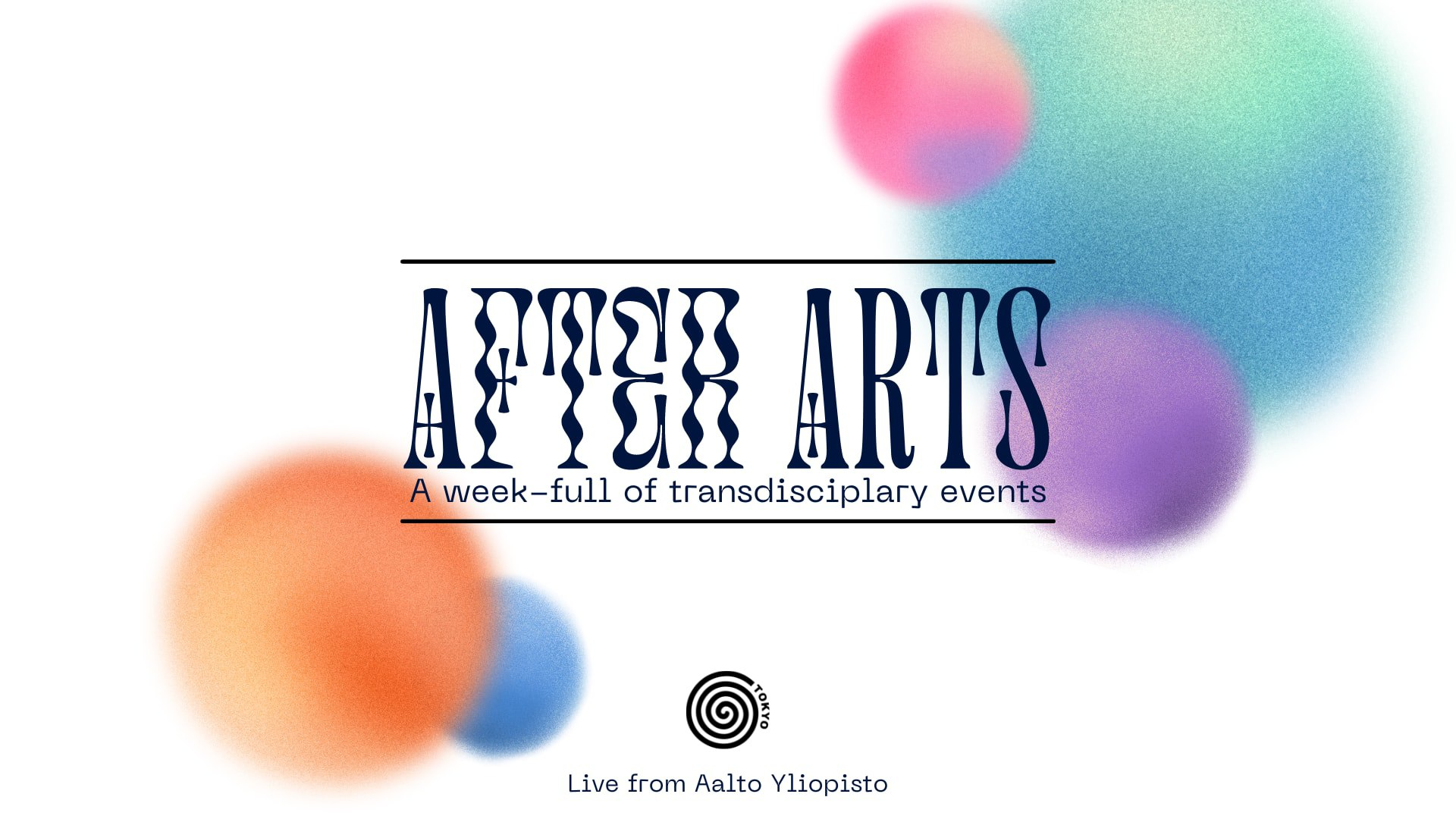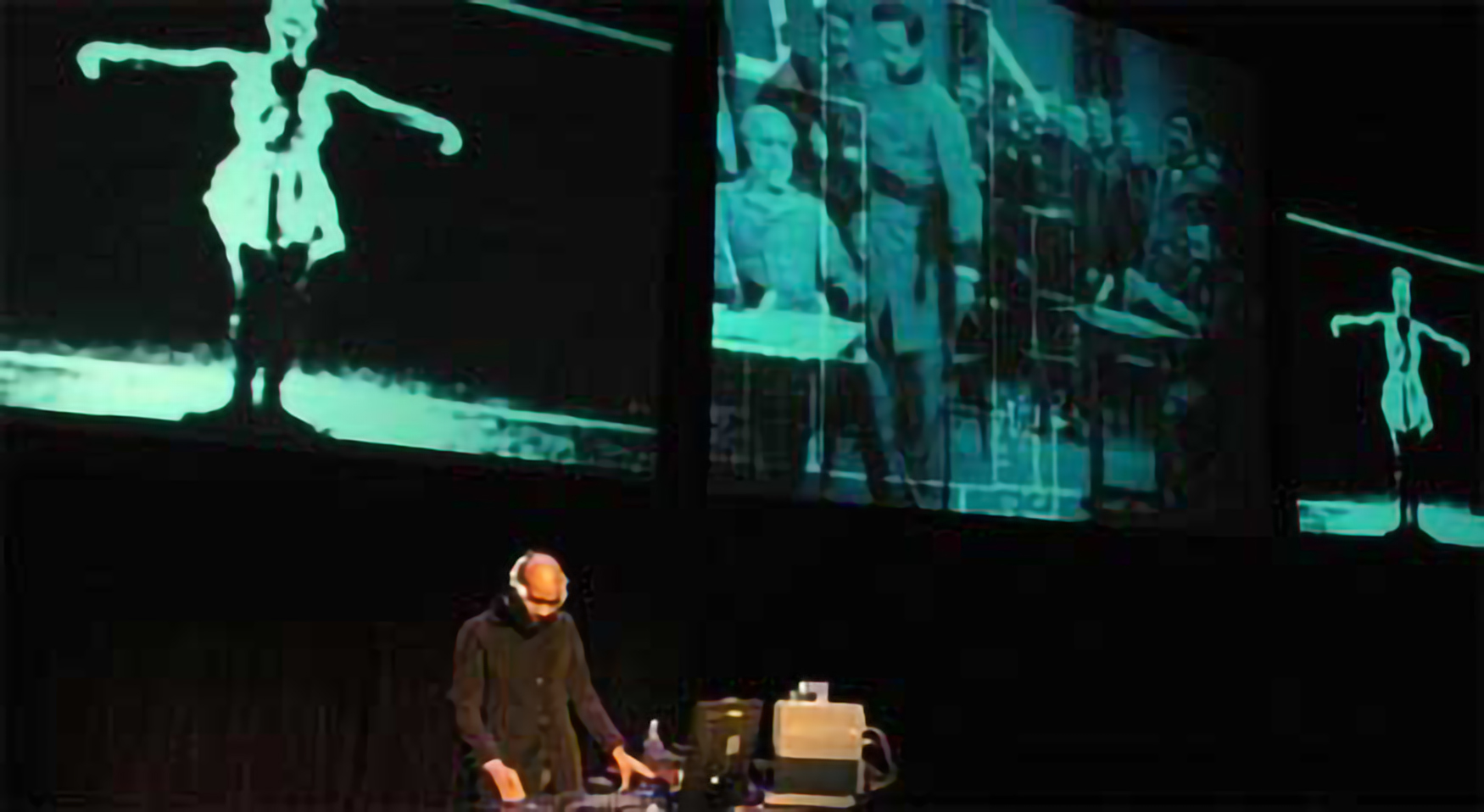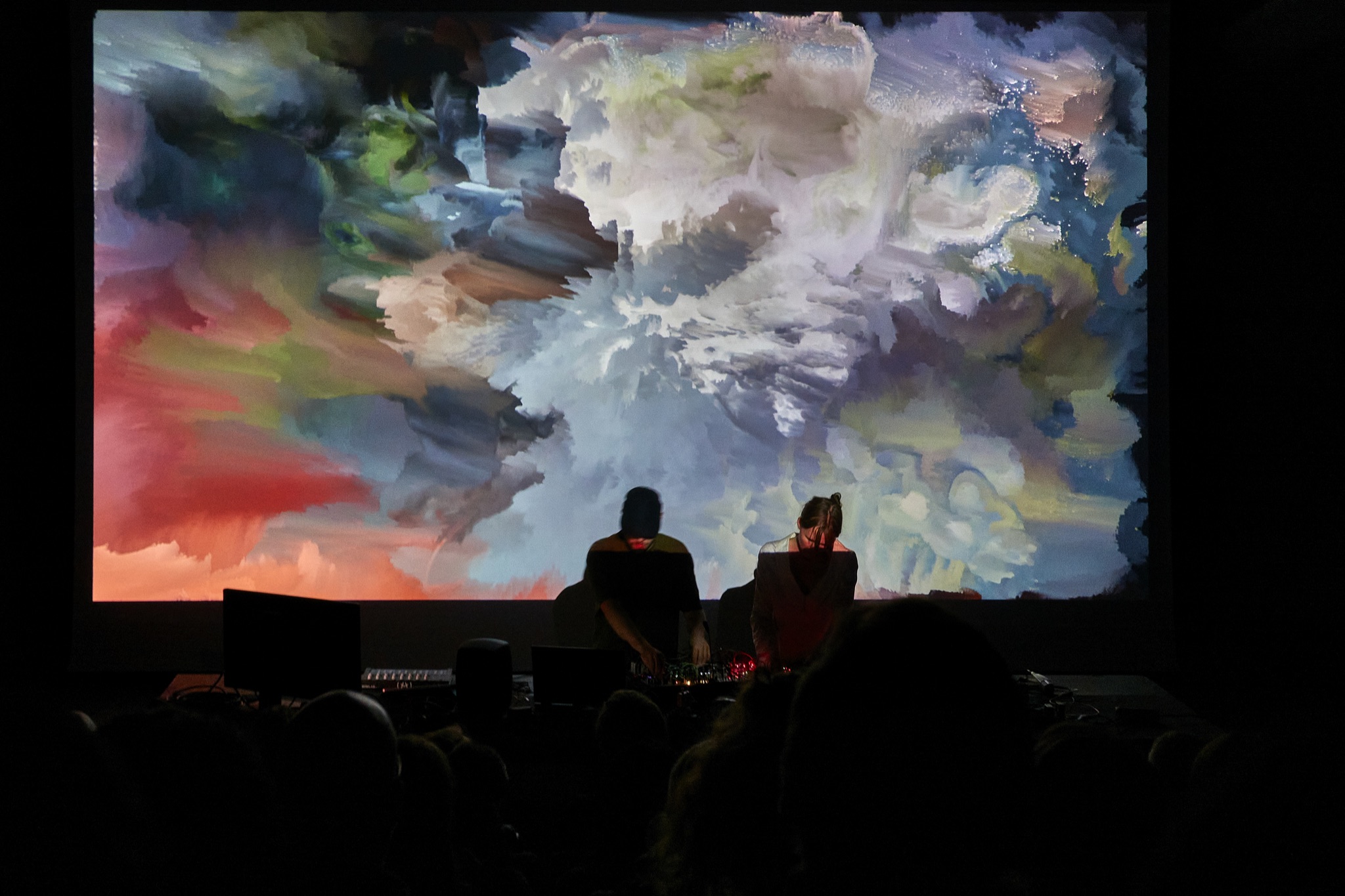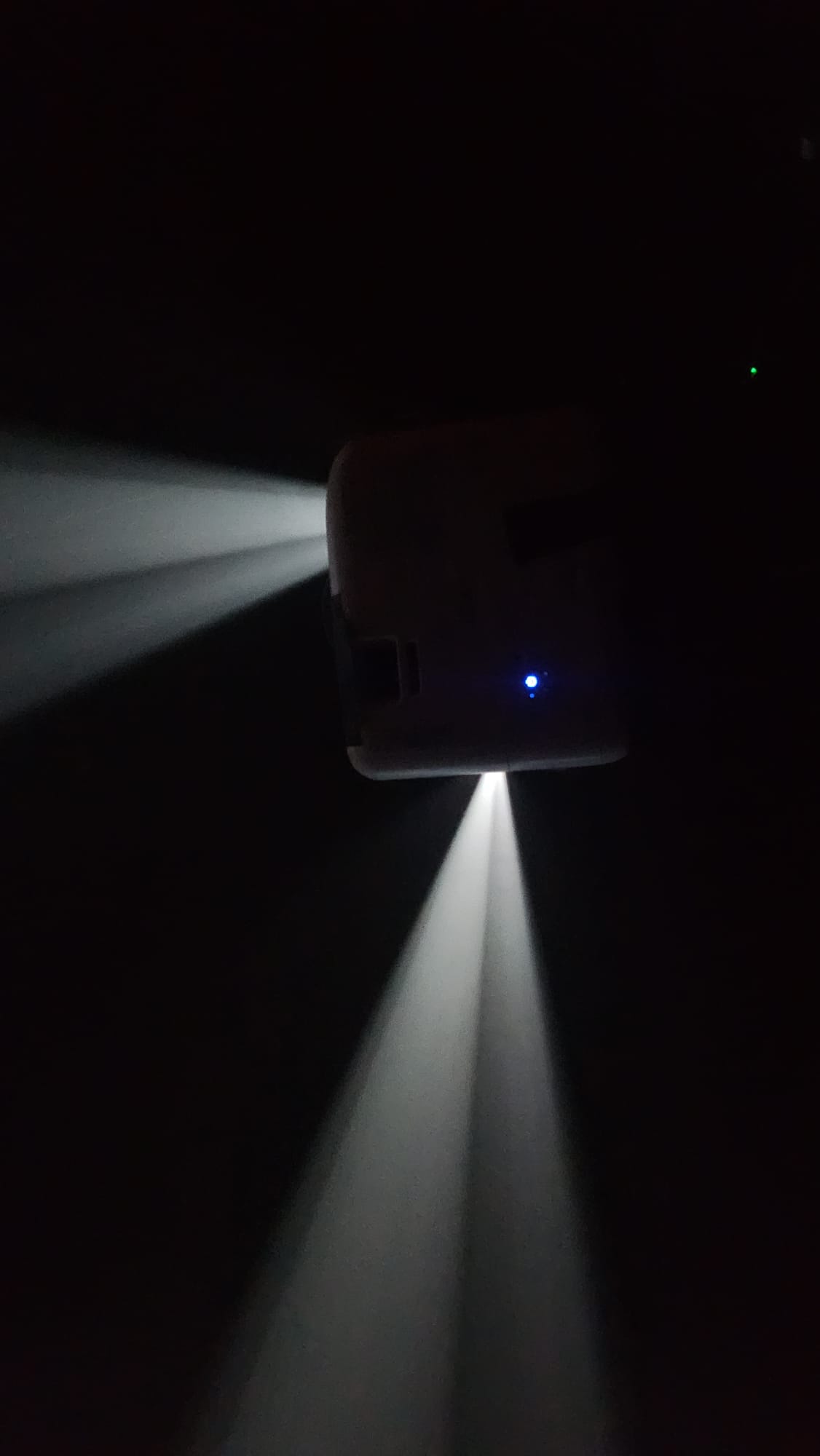VJ Workshop
Beyond Traditional VJing #
What lies beyond loops? How can we expand our connection with our audience? And how can I make my life easier? This is a talk/workshop about different and new approaches to VJing, interactive pieces, and things to do while the machines do the work for you.
TOKYO, the Aalto ARTS student association, aims to break down the silos between different student groups, to build inspiring new connections and networks, and develop a culture of inspiring discussions at Aalto. Both students and staff are welcome to participate in the AFTER ARTS week programme! Exhibitions, workshops and professional talks will take place from Monday to Friday 30 October to 3 November 2023.
Workshop Contents #
This workshop will cover the following topics:
- Historical and contemporary context of VJing
- Different approaches to VJing
- Demos of tools and techniques including: TouchDesigner, p5Live, TouchOSC, DMX, and VDO
What is VJing? #
VJing, or video jockeying, is a form of live performance art that involves the manipulation and projection of visual content in synchronization with music or other audio. The origins of VJing can be traced back to the 1960s, when experimental filmmakers began to incorporate live video mixing into their performances. Visuals can complement the music by providing an additional layer of sensory stimulation. They can also help to create a more immersive environment for the audience, and can be used to convey a specific mood or emotion that complements the music. However, it wasn’t until the 1980s and the rise of electronic dance music that VJing began to gain widespread popularity.
In the early days of VJing, the technology was relatively primitive, with VJs using analog video mixers and simple effects processors to create their visuals. However, with the advent of digital technology in the 1990s, VJing began to evolve rapidly. VJs now had access to powerful software tools that allowed them to create complex, layered visuals in real time, and to synchronize their visuals with music and other audio.
Today, VJing work in a variety of contexts, from nightclubs and music festivals to art galleries and museums. They use a wide range of tools and techniques to create their visuals, from custom software and hardware to off-the-shelf products like Resolume and TouchDesigner. More and more the live between VJing and other forms of live performance art, such as DJing and live coding, is becoming blurred.
All Reactive, All Realtime #
Loops are often used in VJing because they provide a reliable and predictable visual element that can be synchronized with the music. However, relying solely on loops can limit the creative potential of a VJ performance. Moving away from loops can involve incorporating more interactive and generative elements into the performance. This can include using sensors or cameras to capture live input from the audience or the environment, and using that input to generate visuals in real-time.
Generative Art #
Generative art can be used in contemporary VJing to create unique and dynamic visuals that respond to live input from the audience or the environment. Generative art involves the use of algorithms and rules to create art that is constantly evolving and changing. These visuals that are synchronized with the music or other audio, and that respond to live input from sensors or cameras. Similarly, these visuals can be unique and unpredictable. This can help to create a sense of excitement and anticipation among the audience, as they never know what to expect from the visuals. Additionally, generative art can be used to create visuals that are more organic and natural, as they are not limited to the use of pre-made loops or static images.
Corruption Art #
Data moshing is a technique that involves intentionally corrupting the data of a video file to create visual artifacts and glitches. This technique can be used in VJing to create unique and dynamic visuals that are not possible with traditional video editing techniques.
Data moshing can push forward the aesthetics of VJing by introducing a new visual language that is not limited to traditional video editing techniques. It can create a sense of unpredictability and excitement among the audience, as they never know what to expect from the visuals. Some tools like EBSynth, Supermosh, MadPixelSort can achieve different corruption styles.
Live Coding #
Live coding is a technique that involves writing and modifying code in real-time during a performance. In the context of VJing, live coding can be used to create and manipulate visuals in real-time, allowing for a more dynamic and interactive performance.Additionally, live coding can be used to create custom software tools and effects that are tailored to the specific needs of a performance.
Improvisation #
Odd Setups #
As a VJ, you can experience a wide range of setups, from small underground clubs to massive theaters with hundreds of speakers and large screens. In smaller venues, you may be working with limited equipment and space, requiring you to be creative with your setup and use of technology. You may need to work with a small table in the back of a corner, or even just a laptop and a projector. In larger venues, you may have access to more advanced equipment, such as multiple projectors, LED screens, and high-end audio systems.
Regardless of the setup, a VJ must be fluent in both the technology and aesthetics of their craft. They must be able to adapt to the environment and work with the equipment available to them. For example, in a small club, a VJ may need to use creative techniques to make the most of limited space and equipment. They may need to use projection mapping to create the illusion of a larger screen, or use generative art to create dynamic visuals that don’t require a large screen.
In larger venues, a VJ may need to work with multiple projectors and screens, and synchronize their visuals with a complex audio system. They may need to work closely with the sound engineer to ensure that the visuals and audio are perfectly synchronized. They may also need to create custom content that is tailored to the specific needs of the performance, such as creating visuals that respond to the music or the audience.
Guerilla Projection #
Guerrilla projection is a technique that involves projecting images or videos onto public spaces without permission. This technique has been used by VJs and new media artists to create temporary installations that challenge the traditional boundaries of public and private space. Guerrilla projections can be used to create immersive and interactive experiences that engage the audience and transform the way they perceive their sometimes overlooked regular enviroment.
More than Rectangles #
Projection mapping is a technique that allows for the projection of images onto non-traditional surfaces, such as buildings, sculptures, and other objects. This technique allows for the creation of immersive and interactive experiences that can transform the way we perceive our environment.
One of the benefits of projection mapping is that it allows for the creation of large-scale installations that can be viewed from a distance. This makes it ideal for use in public spaces, such as city squares, where it can be used to create a sense of community and engagement. In addition to projection mapping, large screen projections and light installations are also becoming increasingly popular. These installations can be used to create stunning visual displays that can be viewed from a distance, as it allows for the creation of immersive and interactive experiences that can transform the way we perceive our environment.
Generative AI #
Currently , with the new developments in Ai, it is possilbe to create aesthetics that were not possible before, and the accesibility of these tools allow virtually any person to be able to create new visual ideas. Some of the tools are:
An example of someone working with these tools is Guli Silberstein
Some Tools of the Trade #
Resolume #
Resolume is a software that allows you to create and perform live visual shows. It is used by VJs, artists, and designers to create visuals for concerts, festivals, and other events.
TouchDesigner #
TouchDesigner is a visual development platform that allows you to create interactive and immersive experiences. It is used by artists, designers, and developers to create interactive installations, live performances, and more.
MadMapper #
MadMapper is a software that allows you to create projection mappings and video installations. It is used by VJs, artists, and designers to create immersive and interactive experiences. With MadMapper, you can map video onto any surface, such as buildings, sculptures, and other objects, and create stunning visual displays that can be viewed from a distance.
Spout & Syphon #
Spout and Syphon are technologies that allow for real-time sharing of video and images between different software applications on the same computer. Spout is a Windows-based technology, while Syphon is a Mac-based technology. Both technologies work by creating a shared memory buffer that can be accessed by multiple applications simultaneously, allowing for seamless integration of different software tools in a VJ setup. For example, a VJ could use Resolume to create visuals and then use MadMapper to map those visuals onto a 3D object, all while using Spout or Syphon to share the video output between the two applications in real-time.
TouchOSC #
TouchOSC is a mobile app that allows you to create custom control interfaces for controlling software and hardware. It is often used by VJs and other performers to create custom interfaces for controlling their live visual shows. The app allows you to create custom buttons, sliders, and other controls that can be mapped to various parameters in your software or hardware setup. TouchOSC can be used on both iOS and Android devices, and it can communicate with your computer or other devices over Wi-Fi or MIDI.
Streaming #
There are several tools that can be used to get streaming real-time video a VJ setups, such as:
DMX #
DMX is a lighting control protocol that is used to control lighting fixtures such as LED strips, moving heads, and other lighting fixtures. It is often used by VJs and other performers to control the lighting in their live visual shows. DMX can be used to control the color, intensity, and other parameters of lighting fixtures. It can also be used to synchronize the lighting with the music or other audio.
Cameras & Sensors #
Cameras and sensors can be used to capture live input from the audience or the environment, and use that input to generate visuals in real-time. For example, a camera could be used to capture the movement of the audience, and that movement could be used to generate visuals that respond to the music or other audio. Similarly, a sensor could be used to capture the temperature of the room, and that temperature could be used to generate visuals that respond to the music or other audio. Some tools that can be used are:
Festivals and Events #
Aavistus VJ Festival #
Aavistus Festival is a biennial festival of audiovisual art and VJ culture, which is currently Finland’s only festival to focus on the latter. The festival presents audiovisual live performances, VJ performances, projection mapping works, an exhibition of audiovisual art, and more. It is organized by local VJs, light designers, and event producers 12. The festival has been held twice so far, in 2020 and 2022. In 2022, the festival hosted over 2800 visitors from 14 countries at 6 venues. The next edition of the festival will be held in Helsinki on 3-6 October 2024.
Kinomural Projection Festival #
Kinomural Festival is an annual event that takes place in Wroclaw, Poland. It is a celebration of audio-visual art and features moving murals created by audio-visual artists from all around the world. The festival is held once a year, and the walls of the city come to life with stunning visuals that are projected onto them.
Sónar Festival #
Sónar Festival is an annual music, creativity, and technology festival that takes place in Barcelona, Spain. The festival was founded in 1994 and it is divided into two parts: Sónar by Day and Sónar by Night. Sónar by Day features concerts, showcases, and exhibitions that take place in various venues across the city. Sónar by Night features live music performances and DJ sets.
Punto y Raya Festival #
Punto y Raya Festival is an international festival that celebrates abstract art in motion. It is also known as the “most abstract festival in the world”. The festival is organized by MAD - Moviment d’Alliberament Digital, a non-profit association that aims to promote cultural engineering through the development of projects involving art, science, and technology. The festival explores the ultimate synthesis of the form-movement duality in different spheres of human endeavor.



